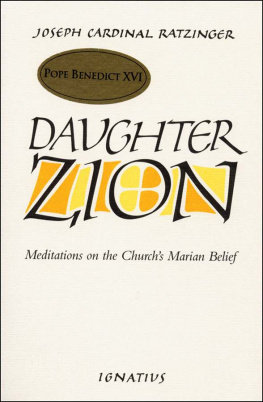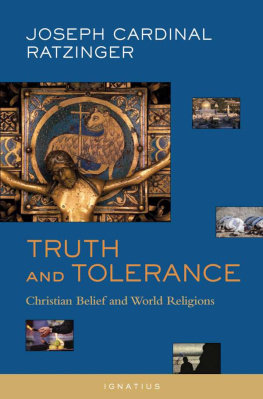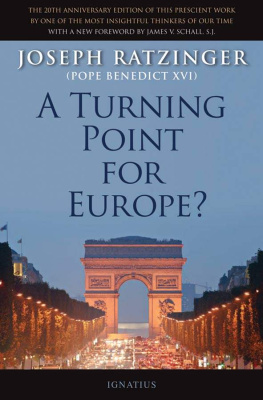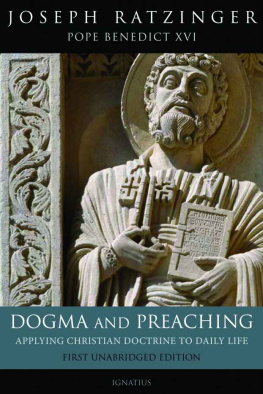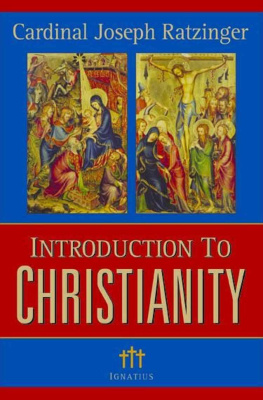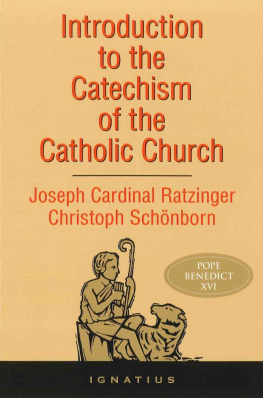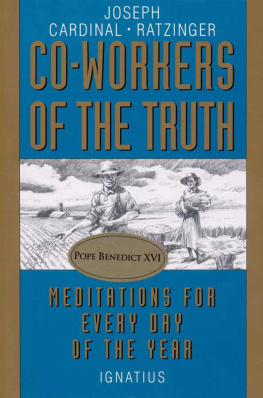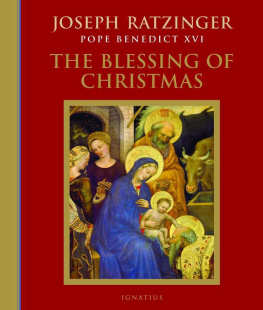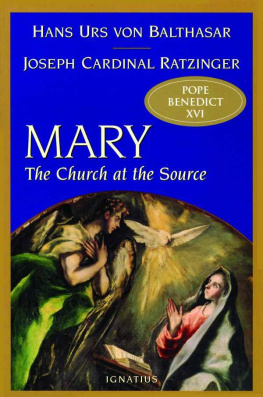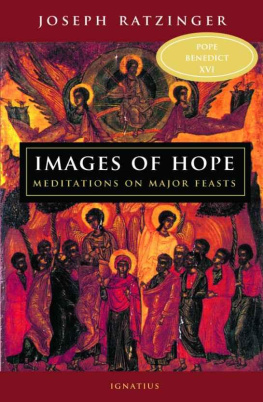Joseph Cardinal Ratzinger - Daughter Zion: Meditations on the Churchs Marian Belief
Here you can read online Joseph Cardinal Ratzinger - Daughter Zion: Meditations on the Churchs Marian Belief full text of the book (entire story) in english for free. Download pdf and epub, get meaning, cover and reviews about this ebook. year: 2005, publisher: Ignatius Press, genre: Religion. Description of the work, (preface) as well as reviews are available. Best literature library LitArk.com created for fans of good reading and offers a wide selection of genres:
Romance novel
Science fiction
Adventure
Detective
Science
History
Home and family
Prose
Art
Politics
Computer
Non-fiction
Religion
Business
Children
Humor
Choose a favorite category and find really read worthwhile books. Enjoy immersion in the world of imagination, feel the emotions of the characters or learn something new for yourself, make an fascinating discovery.
- Book:Daughter Zion: Meditations on the Churchs Marian Belief
- Author:
- Publisher:Ignatius Press
- Genre:
- Year:2005
- Rating:4 / 5
- Favourites:Add to favourites
- Your mark:
- 80
- 1
- 2
- 3
- 4
- 5
Daughter Zion: Meditations on the Churchs Marian Belief: summary, description and annotation
We offer to read an annotation, description, summary or preface (depends on what the author of the book "Daughter Zion: Meditations on the Churchs Marian Belief" wrote himself). If you haven't found the necessary information about the book — write in the comments, we will try to find it.
Joseph Cardinal Ratzinger: author's other books
Who wrote Daughter Zion: Meditations on the Churchs Marian Belief? Find out the surname, the name of the author of the book and a list of all author's works by series.
Daughter Zion: Meditations on the Churchs Marian Belief — read online for free the complete book (whole text) full work
Below is the text of the book, divided by pages. System saving the place of the last page read, allows you to conveniently read the book "Daughter Zion: Meditations on the Churchs Marian Belief" online for free, without having to search again every time where you left off. Put a bookmark, and you can go to the page where you finished reading at any time.
Font size:
Interval:
Bookmark:
Daughter Zion
Joseph Cardinal Ratzinger
Meditations on the Churchs Marian Belief
Translated by John M. McDermott, S.J .
IGNATIUS PRESS SAN FRANCISCO
Title of the German original:
Die Tochter Zion
1997 Johannes Verlag, Einsiedeln
Cover by Victoria Hoke Lane
With ecclesiastical approval
1983 Ignatius Press, San Francisco
All rights reserved
ISBN 0-89870-026-4
Library of Congress catalogue number 82-084579
Printed in the United States of America
This small book, which I am now offering to the public, reproduces three lectures presented in the spring of 1975 in Puchberg bei Linz. After the Marian element had played a reduced role in the life of the Church for many years, people wanted, in all sobriety, to hear what actually now remained of Marian belief, and what should continue to remain. I therefore limited myself to providing an introduction which did not need to be complete with regard to details, but which did have to indicate correctly the perspective from which detail and whole alike might be properly understood.
Thus the intention and the limits of this publication are marked off at a single stroke. In my revision of it, I deliberately avoided changing its overall character. This book is intended, certainly not to replace a comprehensive treatise, but merely to open the readers eyes to the layer of meaning that can then make the approach to larger works possible. To prevent the blurring of this small essays limitations, I have intentionally left unaltered the more informal, improvisational characteristics which may mark the literary style of a lecture. Even an appropriate completion of the lectures content, e.g., by a study of Matthews testimony about the virgin birth, did not seem to me to be required by the overall objective of the work. I hope that this small book can, in its own way, help towards a new understanding and appropriation of what should not be lost in the Churchs Marian belief.
Finally, I do not wish to neglect giving my heartfelt thanks to my respected friend Hans Urs von Balthasar for having patiently wrested this manuscript from me and for having, once again, seen it through the press after my call to become archbishop of Munich and Freising, which, announced publicly on the Feast of the Annunciation, overwhelmed me with new tasks.
Pentling, the Feast of the Ascension, 1977
Joseph Ratzinger
Chapter I
A discriminating observer of the Churchs life today will discover a peculiar dichotomy in the Churchs Marian belief and devotion. On the one hand, the impression is given that Mariology is a scaled-down duplicate of Christology that somehow arose on irrational grounds; or even more, it appears to be but the echo of ancient models found in the history of religions, which ineradicably returns to claim its position and value even in Christianity, although closer examination shows that there are neither historical nor theological grounds to support it. Historical support is lacking because Mary obviously plays scarcely any role in Jesus career; she appears, rather, under the sign of misunderstanding. Theological support is lacking because the Virgin-Mother has no place in the structure of the New Testament credo. Indeed, many find no embarrassment in identifying the non-Christian origin of Marian belief and devotion: from Egyptian myths, from the cult of the Great Mother, from Diana of Ephesus, who, entirely on her own, became Mother of God () at the council convened in Ephesus.... On the other hand, there are those who plead for a magnanimity with regard to diverse types of piety: without puritanical tendencies, we should just leave the Romans their madonnas. Behind this generosity can be seen an attitude which becomes noticeably stronger as a result of the trend toward the rationalization of Christianity: namely, the longing for a response in the religious sphere to the demands of emotion; and after that, the longing for the image of woman as virgin and mother to have a place in religion as well. Of course, mere tolerance in the face of manifold customs will not suffice to justify Marian piety. If its basis is as negligible as might appear from the considerations just mentioned, then the continued cultivation of Marian piety would be nothing but a custom contrary to truth. Such customs either wither away because their root, the truth, has dried up, or they continue to proliferate contrary to conviction, and thus destroy the correlation between truth and life. They thereby lead to a poisoning of the intellectual-spiritual organism, the results of which are incalculable.
Thus there is need of deeper reflection. Before entering into an examination of individual texts, we must direct our attention to the whole picture, the question of structure. Only in this way can a meaningful arrangement of individual elements be obtained. Is there any place at all for something like Mariology in Holy Scripture, in the overall pattern of its faith and prayer? Methodologically, one can approach this question in one of two ways, backwards or forwards, so to speak: either one can read back from the New Testament into the Old or, conversely, feel ones way slowly from the Old Testament into the New. Ideally both ways should coincide, permeating one another, in order to produce the most exact image possible. If one begins by reading backwards or, more precisely, from the end to the beginning, it becomes obvious that the image of Mary in the New Testament is woven entirely of Old Testament threads. In this reading, two or even three major strands of tradition can be clearly distinguished which were used to express the mystery of Mary. First, the portrait of Mary includes the likeness of the great mothers of the Old Testament: Sarah and especially Hannah, the mother of Samuel. Second, into that portrait is woven the whole theology of daughter Zion, in which, above all, the prophets announced the mystery of election and covenant, the mystery of Gods love for Israel. A third strand can perhaps be identified in the Gospel of John: the figure of Eve, the woman par excellence , is borrowed to interpret Mary.
These first observations, which we shall have to pursue later, offer us a guide into the Old Testament; they indicate where those elements lie which are pregnant with the future. All consequent Marian piety and theology is fundamentally based upon the Old Testaments deeply anchored theology of woman, a theology indispensable to its entire structure. Contrary to a widespread prejudice, the figure of woman occupies an irreplaceable place in the overall texture of Old Testament faith and piety.
From the above considerations, it has been concluded that women had no role at all in the faith of the Old Testament, and that there is and can be no theology of woman because the Old Testaments chief concern is precisely the opposite: to exclude woman from theo-logy, from the language of God. This would then mean that Mariology de facto could only be seen as the infiltration of a non-biblical model. Consistent with this view would be the contention that at the Council of Ephesus (431), which confirmed and defended Marys title as Mother of God, the previously rejected Great Mother of pagan piety had in reality secured a place for herself in the Church. This views presuppositions about the Old Testament, however, are false. For even though the prophetic faith rejects the model of deities set in syzygies, i.e., in pairs, and the cultic expression of this model in sacred prostitution, it gives to woman, in its own way, an indispensable place in its own model of belief and life, corresponding to marriage on the human level. This is admittedly obscured in the Old Testament by many compromises, but what Jesus maintains in Mark 10:1-12 and what Ephesians 5 then further explains theologically is entirely the consequence of Old Testament theology. Along with this consequence, the idea and reality of virginity also emerge. For virginity is most intimately connected to the theological foundation of marriage; it does not stand in opposition to marriage, but rather signifies its fruit and confirmation.
Next pageFont size:
Interval:
Bookmark:
Similar books «Daughter Zion: Meditations on the Churchs Marian Belief»
Look at similar books to Daughter Zion: Meditations on the Churchs Marian Belief. We have selected literature similar in name and meaning in the hope of providing readers with more options to find new, interesting, not yet read works.
Discussion, reviews of the book Daughter Zion: Meditations on the Churchs Marian Belief and just readers' own opinions. Leave your comments, write what you think about the work, its meaning or the main characters. Specify what exactly you liked and what you didn't like, and why you think so.

